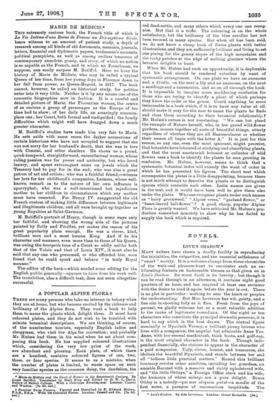A POPULAR ALPINE FLORA.f
THERE are many persons who take no interest in botany when they are at home, but who become excited by the richness and brilliancy of the Alpine flora. They want a book to help them to name the plants which delight them. It must have coloured plates, and they do not wish to be troubled with minute botanical descriptions. We are thinking, of course, of the numberless tourists, especially English ladies and clergymen, who visit the Alps for recreation; and probably Mr. Hulme had them in his mind when he set about com- posing this book. He has supplied coloured illustrations which, considering the very low price of the work, are abundant and pleasing. Each plate, of which there are a hundred, contains coloured figures of one, two, three, or four species. It seems to us a mistake, when the number of plates is limited, to waste space on such very familiar species as the common daisy, the dandelion, the • Maria 4. MCclicis and the Court of France in the Seventeenth Century. By Louis Batiffol. Translated by Mary King and Edited by N. W. C. Davis, Fellow of Ballot College. With a Collotype Frontispiece. London: Chattcl and Windus. [7s. 64. net.]
t Familiar Swiss Flowers. Figured and Described by P. Edward Maine F.L.B., F.S.A. With 100 Coloured Plates. London Cassell and Co. [7e. ed. net.]
red dead-nettle, and many others which every one can recog- nise. But that is a trifle. The colouring is on the whole satisfactory, but the brilliancy of the blue corollas has not been secured in many species. But when all has been said, we do not know a cheap book of Swiss plants with better illustrations, and they are sufficiently brilliant and living to set one pining for the grassy slopes of the high mountains and the rooky patches at the edge of melting glaciers where the botanist delights to bunt.
When Mr. Hulme had such an opportunity, it is deplorable that his book should be rendered valueless by want of systematic arrangement. On one plate we have an anemone and a thistle, on the next a lily and an anemone, on the next a saxifrage and a ranunculus, and so on all through the book. It is impossible to imagine more maddening confusion for those who are trying to identify a plant of which perhaps they know the order or the genus. Could anything be more inexcusable in a book which, if it is to have any value at all, should make it easy for the user to name the plants he finds and class them according to their botanical relationship P Mr. Hulme's excuse is not convincing. "We can but plead the example of Nature herself, who, in her grand wild-lower gardens, masses together all sorts of beautiful things, utterly regardless of whether they are all Ranunculacete or whether their names all begin with the letter A." It is just for this reason, as any one, even the most ignorant, might perceive, that botanists have laboured at studying and classifying plants, and that the most amateurish botanist or collector of wild flowers uses a book to identify the plants he sees growing in confusion. Mr. Hulme, however, seems to think that a systematic botanical index will remedy the want of order in which he has presented his figures. The short text which accompanies the plates is a little disappointing, because there is not much attempt to describe the plants or to distinguish species which resemble each other. Latin names are given in the text, and it would have been well to give them also under the plates. Who can recognise plants under such names as "hairy greenweed," "Alpine cress," "garland flower," or "heart-leaved ball-flower"? A good, cheap, popular Alpine Flora is greatly wanted. We have criticised Mr. Hulme's pro- duction somewhat minutely to show why he has failed to supply the book which is required.






















































 Previous page
Previous page